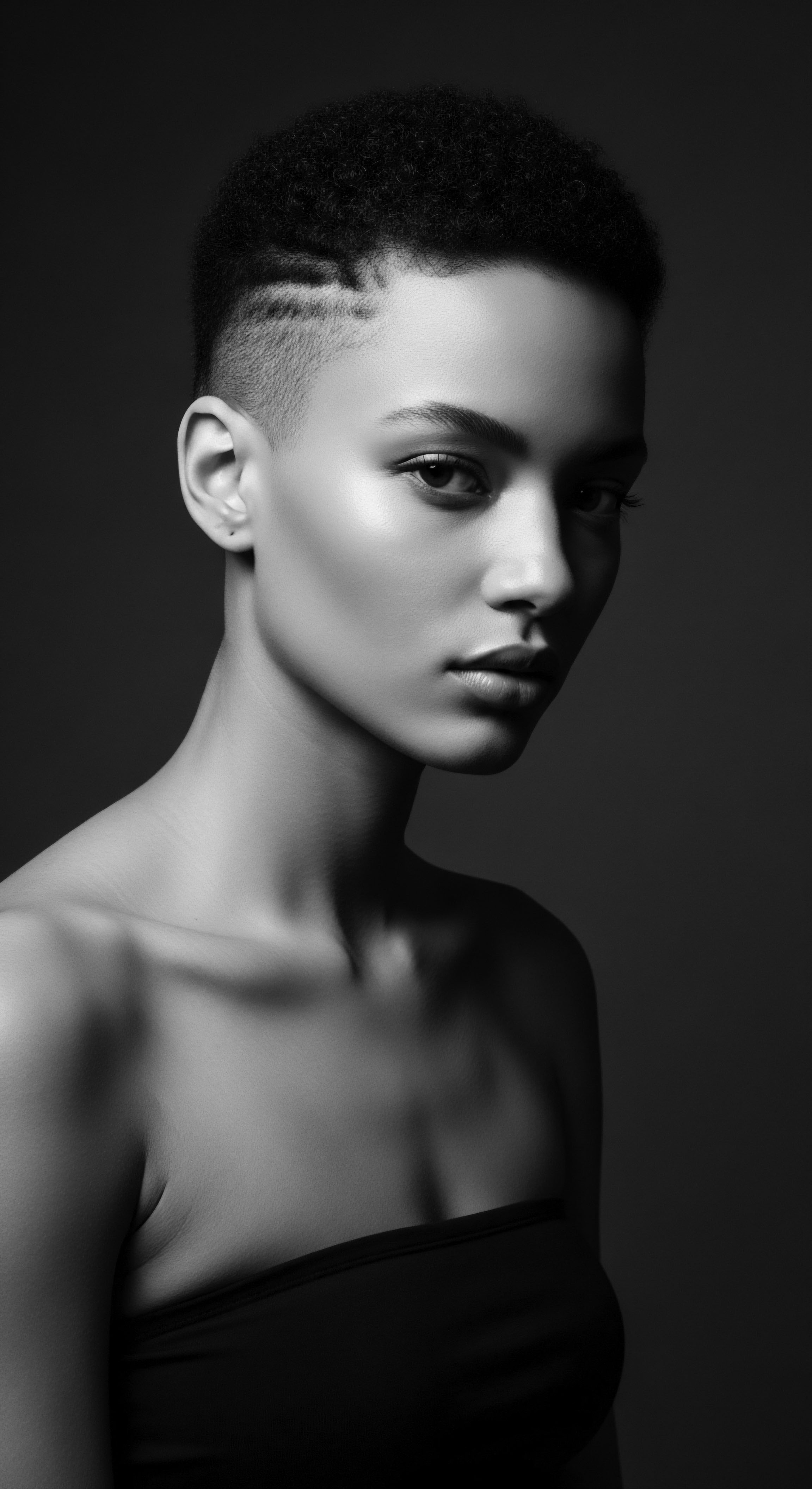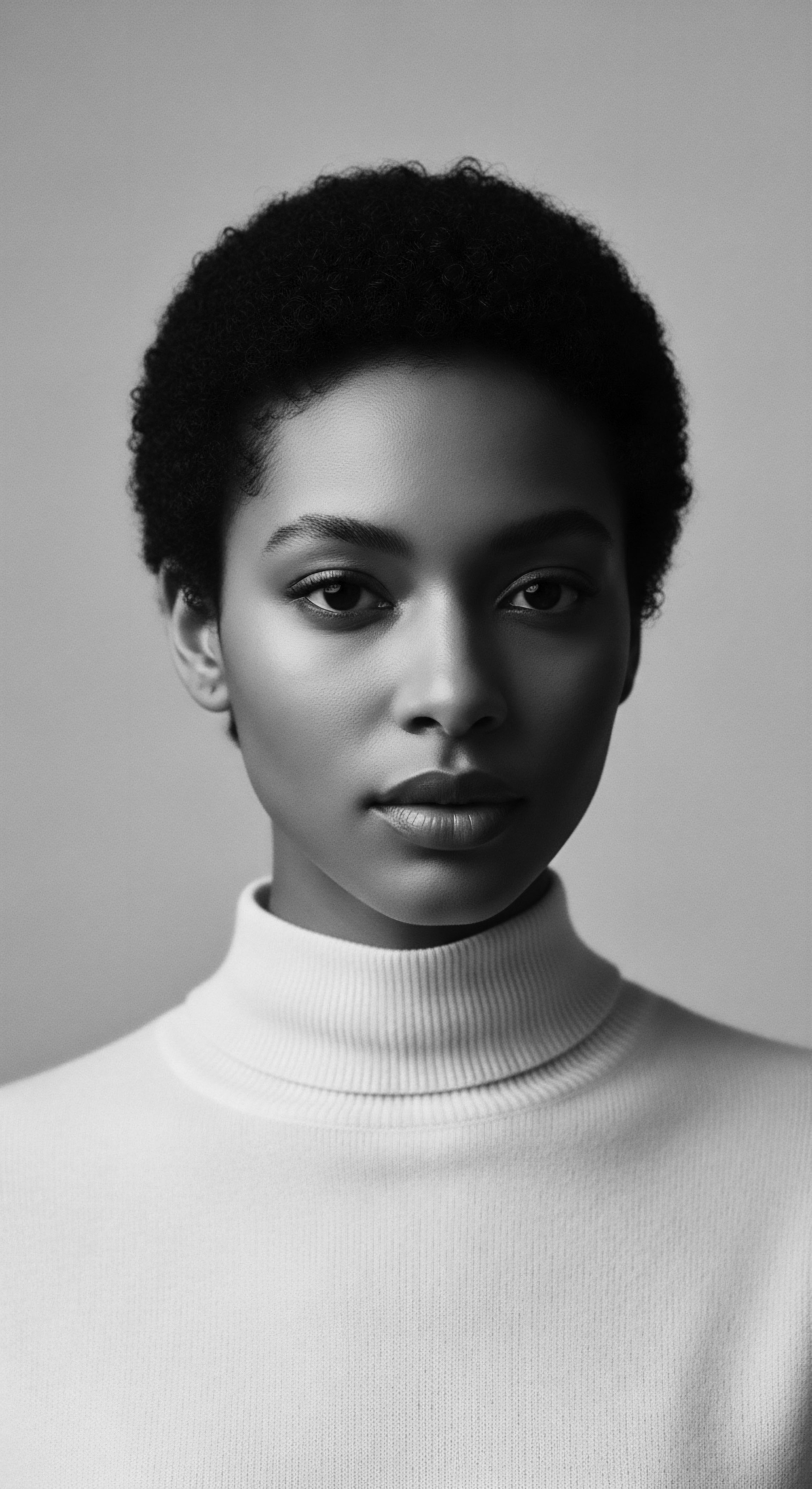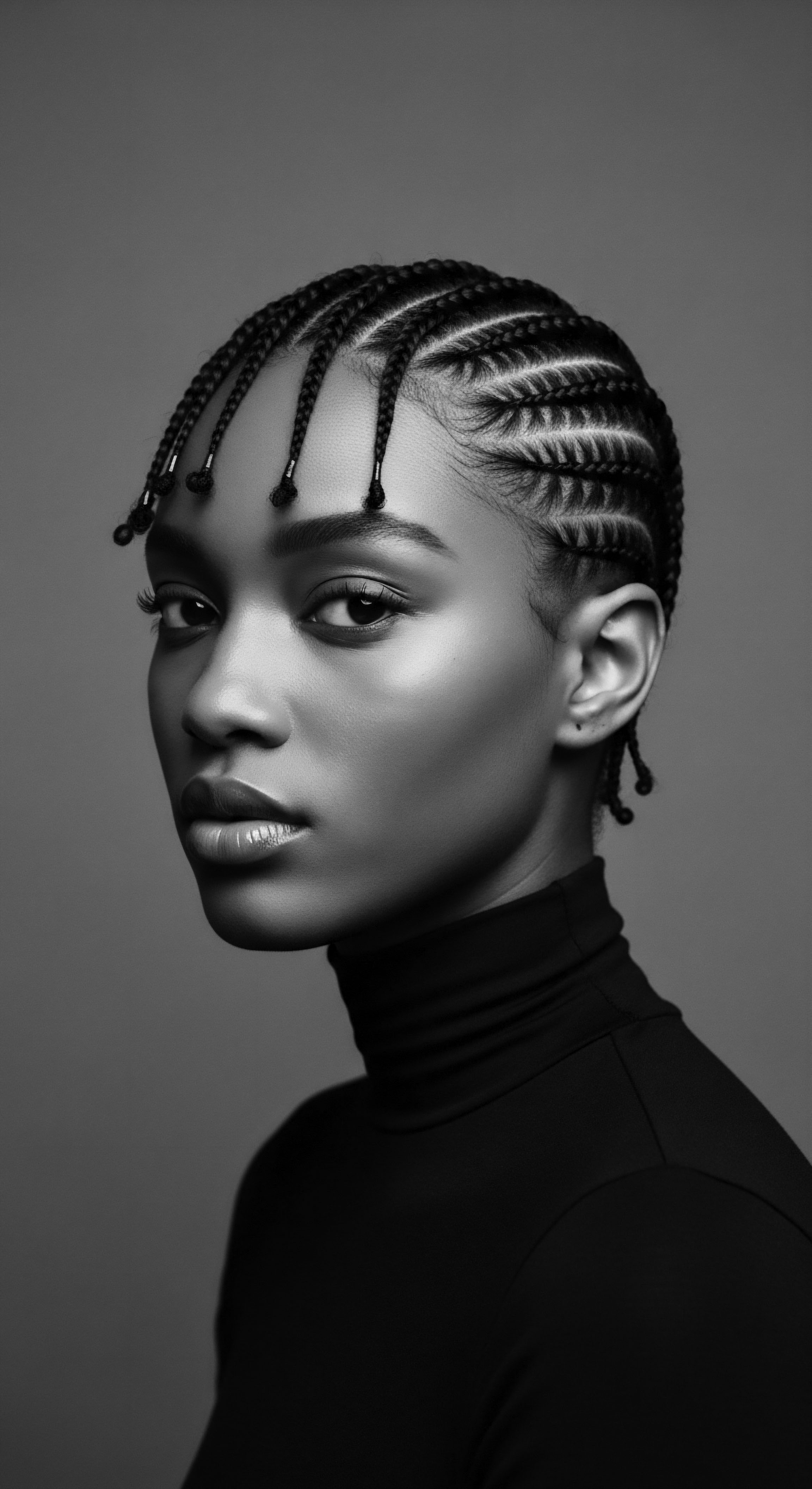
Roots
In every coiled strand, in every spiraled curl, lies a whisper of ages past. This intimate connection, spanning millennia, ties our present-day textured hair care traditions back to the sun-kissed lands of ancient Egypt. The routines, the reverence, the very practices that guide our hands through our ancestral hair today are not mere modern inventions; they echo rituals practiced along the Nile, reflecting a deep, unbroken lineage of care. We stand on the shoulders of those who understood hair not just as adornment, but as a vibrant extension of self, identity, and spirit.

What Did Ancient Egyptian Hair Possess?
To truly grasp the roots of this connection, we must first consider the hair itself. While much iconographic evidence presents a prevailing image of sleek, dark styles, archaeological findings and scientific analysis paint a more expansive picture. Studies of mummified remains have revealed a diversity of hair types among ancient Egyptians, including those with natural waves, curls, and even tightly coiled strands. This physical evidence suggests that the ancient Egyptians, like peoples across the African continent, possessed a spectrum of natural hair textures.
The fundamental anatomy of hair – its protein structure, the cuticle layers, the shape of the follicle – remained constant, yet its presentation varied with origin and environment. The arid climate of Egypt necessitated specific care to maintain moisture and prevent breakage, challenges deeply familiar to those with textured hair today. Such climate-driven solutions became foundational, shaping practices that would carry through generations.

Hair Structure and Its Ancient Appreciation
The keratin scaffolding, the very protein that gives hair its strength and form, was just as present in ancient Egyptian strands as it is in ours. Modern synchrotron imaging of mummified hair confirms the remarkable preservation of this supramolecular organization , suggesting effective ancient preservation methods. This speaks to an intuitive understanding, even without modern microscopes, of hair’s inherent qualities.
Ancient Egyptians, recognizing hair’s resilience, applied fatty substances, often animal fats or plant oils, to protect and style. This ‘hair gel,’ as some modern analyses term it, helped maintain styles in both life and death, an early testament to the desire for lasting hair integrity.
Ancient Egyptian hair practices represent an ancestral wellspring for many modern textured hair care traditions, rooted in a shared understanding of hair’s physical and spiritual significance.
The side-lock of youth, a single braid or tress worn by children, was a distinct marker of childhood across social strata, even appearing in depictions of deities like the infant Horus. This stylistic choice demonstrates an early cultural practice of managing younger hair, often with specific braided styles, akin to how many modern families approach early hair care for their children. It underscores a generational continuity in hair management within cultural settings.

Did Ancient Egyptians Use Oils for Hair Health?
Indeed, the use of natural oils was a cornerstone of ancient Egyptian hair care, directly influencing contemporary traditions. Their daily regimens frequently involved lubricants to protect hair from the harsh desert sun and to keep it supple. Castor oil , a staple in many modern textured hair routines for its perceived growth-stimulating and moisturizing properties, was a commonly found ingredient in ancient Egyptian hair treatments. Similarly, almond oil and sesame oil were applied for nourishment and to maintain smooth strands.
These ancestral choices were not random; they were borne of practical observation and a deep connection to the land’s botanical offerings. The application of these fatty substances not only conditioned the hair but also held styles in place, a dual function that resonates with modern styling creams and gels.
Consider the deliberate use of beeswax and animal fat to set elaborate wigs and extensions. This ancient practice mirrors the application of pomades and styling waxes used today to add hold and sheen to textured hair, particularly for updos or braided styles. The ancient Egyptians were, in essence, pioneering what we now call ‘product application’ with natural, readily available resources. Their understanding of how these substances interacted with hair, even if empirically derived, laid a foundation for generations of hair care.
The practice of mixing colored minerals like galena for kohl with fats and oils also hints at a broader understanding of incorporating functional ingredients into cosmetic applications, extending beyond just the hair itself but showing a general approach to beauty preparations.

Ritual
The very act of tending to textured hair often carries a ceremonial weight, a rhythmic dance of hands and tools that stretches back through time. In ancient Egypt, hair care ascended beyond mere grooming; it became a ritual, a profound expression of social standing, spiritual connection, and aesthetic preference. The elaborate styles, the careful adornments, the tools employed – all speak to a lineage of practices that find vibrant echoes in the modern world of textured hair styling.

How Did Ancient Egypt Shape Styling Traditions?
The ancient Egyptians were master stylists, using braiding, plaiting, and extensions with a sophistication that predates many contemporary methods. Archaeological findings reveal that wigs, often crafted from human hair, plant fibers, or even wool, were meticulously styled into dozens of small plaits. This labor-intensive work, particularly for the elite, created voluminous and intricate looks. These braided foundations, frequently augmented with extensions, directly parallel the protective styling traditions so central to modern textured hair care.
One cannot discuss ancient Egyptian styling without acknowledging the pervasive use of wigs and hair extensions . These were not simply fashion accessories; they served practical purposes too, offering protection from the sun and deterring lice in a hot climate where many kept their natural hair short or shaved. For the elite, wigs were potent symbols of wealth and social status, with the most elaborate ones being highly valued commodities. This historical context provides a deep backdrop for understanding how wigs and extensions, across cultures, have been about more than just aesthetics; they represent protection, status, and the creative alteration of one’s appearance.
The ancient Egyptian mastery of braiding, wig-making, and hair adornment established a historical precedent for the protective and expressive styling techniques cherished within modern textured hair communities.
The ‘Nubian wig,’ popular during the Amarna period, specifically mimicked the short, curly hair worn by Nubian peoples. This stylistic adoption by figures like Queen Nefertiti speaks to an appreciation for, and sometimes appropriation of, diverse African hair textures and styles, further linking ancient Egyptian aesthetics to broader African hair heritage. It stands as a testament to the influence of various regional hair traditions within ancient Egypt’s visual culture.

What Tools Defined Ancient Hair Artistry?
The tools of the ancient Egyptian hairdresser, though simpler in material, shared functional similarities with those found in modern textured hair toolkits. Combs crafted from ivory, bone, or wood, often adorned with animal motifs, are among the oldest hair accessories discovered, dating as early as 3900 BCE. These combs were not only for detangling but also for applying oils evenly through the hair. The careful parting of hair, crucial for creating braids and intricate styles, would have relied on such precise instruments.
Even rudimentary forms of curling tongs , typically made of bronze, existed, heated over fire to achieve waves and curls. While modern versions offer precise temperature control, the underlying principle of shaping hair with heat has ancient roots. This continuous technological thread, from bronze tongs to ceramic irons, highlights a persistent human desire to alter hair’s natural form. The painstaking process of wig creation involved weaving human hair into dozens of fine plaits and securing them with beeswax and animal fat, reflecting an artisanal skill passed down through generations.
Ancient Egyptian Hair Care Tools and Their Modern Counterparts
| Ancient Egyptian Practice/Tool Oils and Fats (Castor, Almond, Animal Fat) |
| Modern Textured Hair Care Counterpart Hair oils, Leave-in conditioners, Pomades |
| Heritage Connection / Purpose Moisture retention, shine, styling hold, scalp health in dry climates. |
| Ancient Egyptian Practice/Tool Braided Wigs and Extensions (Human hair, plant fibers) |
| Modern Textured Hair Care Counterpart Braids, Weaves, Wigs (protective styles) |
| Heritage Connection / Purpose Protective styling, aesthetic expression, social status, hygiene. |
| Ancient Egyptian Practice/Tool Combs (Ivory, Bone) |
| Modern Textured Hair Care Counterpart Wide-tooth combs, detangling combs |
| Heritage Connection / Purpose Detangling, parting, distributing products, hair ornament. |
| Ancient Egyptian Practice/Tool Heated Bronze Tongs |
| Modern Textured Hair Care Counterpart Curling irons, flat irons |
| Heritage Connection / Purpose Styling, creating texture and waves. |
| Ancient Egyptian Practice/Tool Beeswax and Resin |
| Modern Textured Hair Care Counterpart Styling gels, edge controls, setting lotions |
| Heritage Connection / Purpose Setting styles, providing hold and structure. |
| Ancient Egyptian Practice/Tool These parallels demonstrate a continuous thread of hair care ingenuity, linking ancestral methods to today's routines for textured hair. |
The significance of braids in ancient Egyptian culture further connects to the diaspora’s traditions. Box braids, for instance, have archaeological evidence in Egyptian tombs and burial sites, dating back centuries. This indicates that many styles seen today, particularly within Black and mixed-race communities, are not new but represent a deep cultural memory. The sheer longevity of these practices, often tied to social status, hygiene, and aesthetic preferences, reinforces their place in our collective hair heritage.

Relay
The echoes of ancient Egyptian hair practices reverberate with striking clarity within the vibrant realm of modern textured hair care. It is here, in the daily rituals and problem-solving approaches, that we find the most profound continuity, a living relay of ancestral wisdom refined by scientific understanding. The concern for hair health, the preventative measures against environmental damage, and the pursuit of holistic well-being are threads seamlessly woven from past to present.

How Did Ancient Wisdom Guide Hair Wellness?
Ancient Egyptians approached hair care as an integral part of their overall wellness, understanding that external appearance reflected inner vitality. This holistic perspective, prioritizing health over fleeting trends, is a cornerstone of Roothea’s ethos and deeply aligns with modern textured hair care, which emphasizes scalp health, moisture retention, and gentle manipulation. The meticulous grooming practices, from daily washing and oiling to elaborate styling, were not just for aesthetics; they served practical functions, such as protecting hair from the harsh desert climate and mitigating common issues like lice infestations.
Consider the emphasis on scalp health. Priests, for instance, often shaved their heads for purity, suggesting an awareness of hygiene and scalp exposure. While extreme, this practice underscores a focus on the origin point of hair. Ancient remedies against grayness and baldness, though perhaps not scientifically potent by today’s standards, demonstrate a long-standing desire to maintain hair’s youthful vitality and address concerns common across human experience.
The ancient Egyptian commitment to hair protection, restorative treatments, and ceremonial styling established a profound heritage of care, directly informing the intentional regimens of modern textured hair.
One striking instance illustrating this continuity is the ancient Egyptian ‘hair gel.’ Analysis of mummified hair has revealed a fatty substance, likely animal fat or beeswax mixed with other components, used to set hairstyles in place. This discovery holds significant weight for understanding textured hair. For hair with natural curl or coil patterns, external agents are often necessary to define, hold, and reduce frizz, particularly in dry or humid environments.
The ancient Egyptians intuitively understood this need, applying a product that functioned similarly to modern pomades, custards, or styling gels designed for curl definition and hold. This is a direct, tangible link between ancient styling agents and contemporary textured hair product formulations, highlighting a shared functional need across millennia.
The use of henna , a plant-derived dye, was also common for coloring and strengthening hair and nails. This plant-based approach to hair alteration and conditioning finds its counterpart in the contemporary natural hair movement, which often favors botanical ingredients over synthetic chemicals for their perceived health benefits and gentler action. The tradition of sourcing directly from nature for hair adornment and care is a powerful ancestral practice that continues to influence product development today.
The attention to hair was so detailed that the embalming process itself was sometimes adapted to preserve an individual’s hairstyle, ensuring that their chosen look carried into the afterlife. This reveals the deep personal and societal importance placed on hair as a marker of identity, even beyond physical life. The very act of meticulously caring for and styling hair became a part of one’s enduring legacy.

What Specific Treatments Did Ancient Egyptians Employ?
Ancient texts and archaeological finds offer glimpses into specific formulations and treatments. The Ebers Papyrus , a prominent medical text from around 1550 BCE, includes remedies for hair conditions, such as mixtures to promote hair growth. One such remedy involved a blend of ochre, black kohl, antelope oil, and hippo fat.
While some ingredients might seem unusual today, the principle of combining various emollients and pigments for hair treatment remains. Another growth remedy mentioned in the Hearst Papyrus combined oil and fat in equal portions.
Consider the case of the Dakhleh Oasis mummies , excavated from a Greco-Roman cemetery. Researchers found that despite the mummification process, the hair of these individuals had been intentionally styled and coated with a fat-based substance. This styling agent, distinct from the embalming resins used on the body, suggests that hair was treated as a separate, specialized entity during funerary preparations.
This meticulous attention to preserving the hairstyle into eternity underscores the enduring significance of hair as a personal identifier and a symbol of individual beauty. The fact that hair, unlike other body parts, does not significantly degrade morphologically over millennia, likely contributed to this focused preservation.
Ancient Egyptian Hair Treatment Ingredients
- Castor Oil ❉ Known for its moisturizing properties, possibly stimulating growth. Found in ancient cosmetic preparations.
- Almond Oil ❉ Used for nourishment and to maintain smooth, soft hair.
- Animal Fats ❉ Employed as emollients and styling agents, providing hold and shine.
- Beeswax ❉ Used for setting elaborate styles, particularly in wigs and extensions.
- Henna ❉ A plant-based dye for coloring hair and strengthening strands.
The focus on protection extended to nocturnal practices as well. While specific ‘bonnets’ as we know them might not have existed, the use of wigs provided an insulating layer that could protect natural hair underneath. Furthermore, the elaborate nature of many ancient hairstyles and wigs, which required significant time to construct and maintain, suggests that preserving these styles, perhaps through careful covering or specialized resting techniques, would have been a practical necessity to extend their wear. This foresight in protecting styled hair mirrors the modern practice of using satin bonnets or scarves to prevent friction and preserve textured styles overnight.

Reflection
To stand here, at the crossroads of ancient riverbanks and modern beauty aisles, is to feel the persistent pulse of an unbroken heritage . The journey from the meticulous grooming of ancient Egypt to the thoughtful care practices for textured hair today reveals more than just a historical lineage of techniques; it uncovers a shared reverence for hair as a profound expression of self, community, and ancestral connection. Roothea’s ‘Soul of a Strand’ whispers of this very truth ❉ that each curl, coil, and kink carries the wisdom of those who came before, a living archive of resilience and beauty. The ancient Egyptian quest for hygiene, aesthetic presentation, and spiritual alignment through hair care continues, not as a forgotten relic, but as an ever-present influence on how textured hair is understood and celebrated in our contemporary world.
Our daily rituals, the choices of natural oils, the embrace of protective styles, are not merely trends; they are conscious acknowledgements of a deep, living past. This enduring legacy serves as a powerful reminder of the deep well of ingenuity and cultural pride that has always surrounded textured hair.

References
- Fletcher, J. (1995). Ancient Egyptian Hair. British Museum Press.
- Fletcher, J. (1998). Amulets and Ancestors ❉ Ancient Egyptian Jewellery. British Museum Press.
- McCreesh, N. & Gize, A. P. (2011). Ancient Egyptian hair gel ❉ New insight into ancient Egyptian mummification procedures through chemical analysis. Journal of Archaeological Science, 38(11), 3123-3129.
- Robins, G. (2020). Hair, Gender, and Social Status in Ancient Egypt. JSTOR Daily.
- Fletcher, J. & Salamone, F. (2016). An Ancient Egyptian Wig ❉ Construction and Reconstruction. Internet Archaeology, 42.
- Kamal, H. (1996). Dictionary of Pharaonic Medicine. National Publication House.
- Marshall, A. (2025). The magic and power of hair in ancient Egypt. The Past.
- Grapow, H. (1954). Grundriss der Medizin der alten Ägypter II ❉ Die medizinischen Texte in Hieroglyphischer Umschreibung. Akademie-Verlag.
- El-Kasrawy, S.F. (1996). Widow & Widower in Ancient Egypt. Unpublished Thesis.
- Werziniski, W. (1923). Atlas zur Altägyptishchen Kulturgeschichte, Vol. I. Leipzig.
